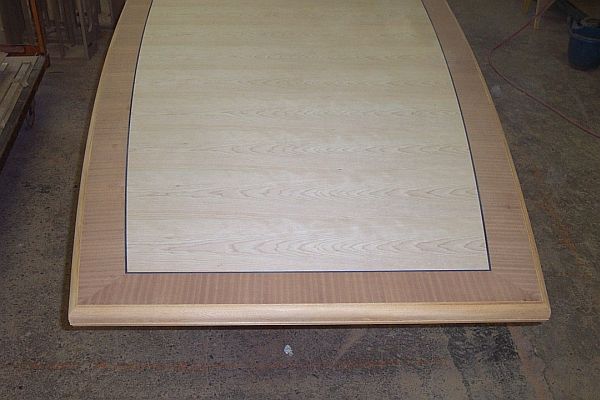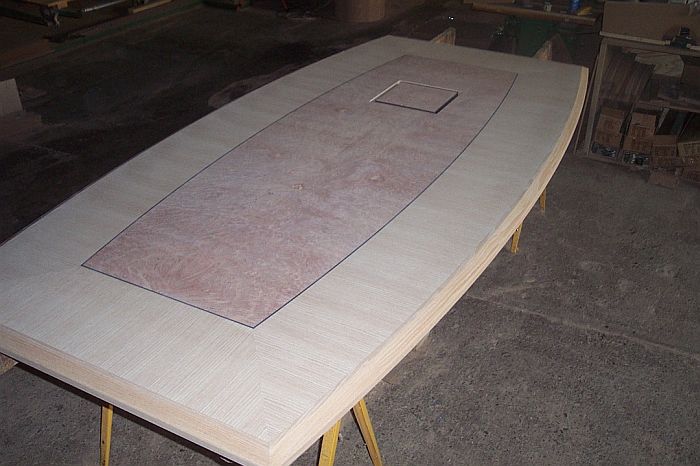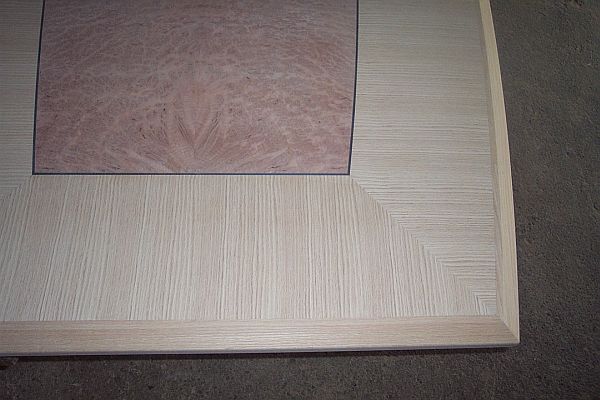Wood Moisture Movement Issues with a Conference Table Top
Here's an extended discussion with photos, about why an architect's wish for a wood table top with mitered corners is impossible to grant. February 10, 2009
Question
We just received a project to build a solid walnut conference table that is 54" wide, 204" long, 2" thick solid walnut. 9" wide x 2" rim mitre, 9" wide x 2" thick field planks. We are concerned with the expansion and contraction that can possibly blow out the mitred corners on the table. I am looking for ideas in the construction or design of the tabletop to prevent the blowout of corners with solid walnut.
Forum Responses
(Architectural Woodworking Forum)
From contributor M:
I know that this is not helpful but I don't believe that what you are being asked to do is doable. The solid wood will always eventually blow out the mitres. The only way I can see that you might have a chance is if you can leave an expansion gap between the inner and the frame along the length of the table. This will however not look that great.
From contributor K:
If you do miters of that size, you had better get them to sign a contract saying that it is not your problem when it fails. If you can get them to go with a nautical look, you can construct it with a 3/16' gap, which can be filled with something like 3M 5200, which is a boat caulk/adhesive. It is tough, and elastic enough that the small movement shouldn't be a problem. But it only comes in white and black.
From the original questioner:
The project was drawn up by an architect for us to bid. We knew this was a concern when we bid the project. I am also looking for responses on design as well. This conference table is going into a lawyer’s office and he is open to design changes to make sure the table turns out nice. I know I might have some responses on using veneer. The owner wants to use his own lumber that has been kiln dried. So the material has to be solid walnut.
From contributor M:
Breadboard ends would be an option.
From contributor A:
Nothing like an architect to ask for the impossible. There is no way that miters will work.
Have the architect come up with some other impossible missions.
From contributor C:
I agree, it would be a disaster to build as described. We do a lot of tables like the one you described for clients and other shops. I would suggest that you do it as a sketch face with a veneer field and border and add just enough walnut around the perimeter to cut the profile. If you cannot do the veneer layup, find a vendor to make it for you. All you would have to do is cut the outer edge, band and profile it.

Click here for full size image

Click here for full size image

Click here for full size image
From contributor D:
You used the word "solid". I wonder if the designer used the same word. If not, you need to reconsider carefully how this thing is to be built. If the word "solid" was used, you need to meet with the designer and teach them a bit about wood and wood movement. They may or may not have asked for the impossible. If they ask for the impossible, it is definitely not your job to proceed as asked. However, it is your opportunity to come up with a technical solution to the design that will give them the look they want, with technical details that will work. It is not going to be solid, though.
While you may not want to hear it, the take on this forum and amongst professionals experienced in this work, is that this is not work for the faint-hearted, light budgeted or inexperienced. The nature of your question - mitered 9" wide solid wood - tells me you do not have the experience or basic knowledge to pull this off.
From the original questioner:
Contributor C - I appreciate the pictures that you submitted. That really helps visualize what you were describing. Contributor D - I appreciate your concern that this is over our head. We will get it figured out. I would rather hear ideas and solutions than belly aching about the architect/designer. I could do that all day and I would be in the same place.
From contributor M:
If the client wants his own wood used that doesn't exclude you from using veneer. Just cut his wood into veneer. And, as others have said explain to everyone why this must be. Most people are understanding. Then make a veneered center with a solid mitred border.
From contributor J:
Before using material provided by the customer, be sure that it's been stored properly and is at an appropriate MC. Having been kiln-dried once upon a time doesn't mean it's dry now.
I agree that miters in a solid 9" frame aren't likely to fare well. A haunched mortise and tenon, perhaps with some pins, could work. You might use some intermediate frame members to break the field into perhaps three or four smaller sections, each carrying a floating panel. The panels should be much thinner than the frame.
If you want a slick, unbroken, grooveless surface then veneer is the only way to do it. Like ml says, there's no reason you can't slice the customer's wood into veneer if you've got a well-tuned bandsaw.
From contributor W:
If they insist on using solid wood just sell them on a slab design without the miters or trim. See if you can get the architect behind you too. If they want to use the wood he has design the table around the material such as a heavy trestle base and solid top that can expand on the base with a button/cleat connection.
From contributor K:
If you still meet a lot of resistance to the design thing, I think it might be a good thing to send both the architect and the client a link to this thread. This is good reinforcement for your reluctance to make the table as it has been designed. It won't be just you against the judgment of the architect. He may be a wiz at aesthetic design, but he obviously needs to go to school on designing to the properties of wood.
From contributor F:
Do everyone involved a favor and get rid of the border. It is easy to make a beautiful tabletop with his planks just do not cross the grain directions. It will not work. I have made a lot of tables and the corners will not look good for even a few weeks, so don't try.
I learned this lesson a long time ago. Wood expands approximately 10 times as much in width as it does in length so there is no way a crossgrained end, mitered or not will stay tight. Even a breadboard end will need a slip joint built in. Some times of the year the breadboard ends will be even and other seasons they will be uneven. I have done kitchen Island tops as big as 6ft by 11ft some with breadboard ends and some with nicely sanded end grain which I think looks best and profiles nicely and finishes well. Try and educate the designer and the owner they will respect you more and give you some leeway in the design process.
From Gene Wengert, forum technical advisor:
A solid wood miter is the most moisture sensitive joint you can make. Further, the wider it is, the greater the sensitivity.
You have two choices: eliminate the miter joint or eliminate all moisture changes. As it is likely that the interior RH will change, summer to winter, the moisture in the wood will change even with the best finish. Trying to prevent solid wood movement in a miter joint when the MC changes is not possible. So, eliminate the miter.
There is another issue and that is the table flatness. Again, moisture changes will cause wood movement, so you need to make 100% certain the RH in your shop is identical (within 2% RH) to the RH that the table will see when it is put in use. This will mean that it will not move initially. You can then hope that seasonal moisture changes are small and slow; or insist to a specific value. This also means that the lumber must be thoroughly equalized to a much stricter standard that most operations drying wood use today, as well as dried to the correct MC (no variation over 1/4% MC and the RH mentioned above would be used to determine the EMC and then the MC of the lumber). Finally, the finish must be the best available for reducing moisture movement (vapor, as well as water from glasses, etc.). Such a finish is applied to both sides, edges, etc. Wax is probably the best; many coats for sure.
One trick that is used for such large tables is to make small grooves in critical places and the grooves will make cracks and movement less obvious. You might do best to have the parties involved hire a consultant knowledgeable about these issues and discuss the why's and so on.
Finally, indicate that you are going to do the best possible, but wood is still wood and movement cannot be eliminated. You cannot be held responsible for such normal wood movement.
From Gene Wengert, forum technical advisor:
Part of a sentence was omitted from above. The correct statement is: you can then hope that seasonal moisture changes are small and slow; or insist that the RH be controlled 24/7/365 to a specific value.


